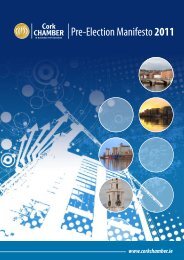Putting People First Guide - Department of Environment and Local ...
Putting People First Guide - Department of Environment and Local ...
Putting People First Guide - Department of Environment and Local ...
You also want an ePaper? Increase the reach of your titles
YUMPU automatically turns print PDFs into web optimized ePapers that Google loves.
<strong>Putting</strong> <strong>People</strong> <strong>First</strong> Summary_Layout 1 16/10/2012 10:50 Page 1A <strong>Guide</strong> to:PuttinG PeoPle <strong>First</strong>Action ProGrAmme For eFFectivelocAl Government
<strong>Putting</strong> <strong>People</strong> <strong>First</strong> Summary_Layout 1 16/10/2012 10:50 Page 2
<strong>Putting</strong> <strong>People</strong> <strong>First</strong> Summary_Layout 1 16/10/2012 10:50 Page 3C o n t en t sF o r e w o r d F r o m t h e m i n i s t er 5V i s i o n 7s u mm a r y o F th e m es 8s t r u C t u r e s t h a t w o r k F o r C o m mu n i t i e s 10F u n d i n g, a C C o u n t a bili t y a n d goV e r na n C e 14e C o n o m i C d eV el o pm e nt a n d J o b C r e at i o n 16d e l i Ve r i n g s e rV i C e s e F F i C i e nt l y 18C o n C l u s i o n 20
<strong>Putting</strong> <strong>People</strong> <strong>First</strong> Summary_Layout 1 16/10/2012 10:50 Page 4
<strong>Putting</strong> <strong>People</strong> <strong>First</strong> Summary_Layout 1 16/10/2012 10:50 Page 5Fo r e w or dlocal government represents <strong>and</strong> serves the citizen. uniquely, it is given afranchise by all residents in irel<strong>and</strong>. putting people <strong>First</strong> involves the mostfundamental set <strong>of</strong> changes in local government in the history <strong>of</strong> the statefrom regional <strong>and</strong> county level through to the municipal level <strong>of</strong> governance.these changes are an integral part <strong>of</strong> the government’s comprehensiveprogramme to improve the way the political system serves our people. thereforms include: making our political funding system more transparent;increasing the participation <strong>of</strong> women; reducing the number <strong>of</strong> tds;establishing the Constitutional Convention; <strong>and</strong> introducing legislation toaddress conflicts <strong>of</strong> interests, lobbying procedures <strong>and</strong> to strengthen our planning system. my department hasa key role in spearheading many <strong>of</strong> these reforms.this action programme, putting people <strong>First</strong>, outlines government policy for reform <strong>and</strong> development rightacross the local government system. the reforms put a strong emphasis on accountability as the bedrock <strong>of</strong> aproperly functioning system <strong>of</strong> local democracy, providing for better engagement with citizens. i believefervently in the need for local government to build strong relationships with <strong>and</strong> gain the interest <strong>of</strong> localpeople. however, local government structures in irel<strong>and</strong> have not been updated since the 19th Century. i amrenewing those structures <strong>and</strong> introducing more effective democratic arrangements, which will increaseefficiency <strong>and</strong> give better value for money for the people it serves. this will involve radical measures, such asa substantial reduction in the number <strong>of</strong> Councillors <strong>and</strong> the number <strong>of</strong> local <strong>and</strong> regional authorities.local government must also operate to the very highest st<strong>and</strong>ards. putting people <strong>First</strong> introduces newdegrees <strong>of</strong> accountability, transparency <strong>and</strong> external scrutiny, as essential pillars <strong>of</strong> local democracy. therewill be a new national oversight <strong>and</strong> audit Commission with external expertise, which will provide a morerobust system <strong>of</strong> performance monitoring with a focus on: key performance indicators, customer service <strong>and</strong>comparative performance <strong>of</strong> local authorities. i will strengthen the role <strong>of</strong> local authority audit Committees<strong>and</strong> i will also review reserved powers under section 140 <strong>of</strong> the local government act 2001 to ensure thatCouncillors will no longer be allowed to direct managers in respect <strong>of</strong> planning functions.local government has been ahead <strong>of</strong> most sectors in the changes it has made to reduce costs <strong>and</strong> driveefficiency, with €830 million savings made since 2008, <strong>and</strong> the sector is well on the way to achieving the €511million savings identified in the report <strong>of</strong> the local government efficiency review group. i will ensure thatlocal authorities continue to vigorously pursue the efficiency agenda, while maintaining essential frontlineservices <strong>and</strong> delivering the highest st<strong>and</strong>ards <strong>of</strong> customer service. the reform programme will yield savings<strong>of</strong> up to €420 million on full implementation.putting people <strong>First</strong> reinforces local government as the primary means <strong>of</strong> public service at local level,harnessing the commitment <strong>of</strong> elected members <strong>and</strong> <strong>of</strong>ficials. For my part, i am committed to buildingstronger, more cohesive local government, giving it a greater capacity not only to address the challenges weface, but also to promote local community, social <strong>and</strong> economic development, <strong>and</strong> collectively to maximise thestrengths <strong>of</strong> our country as a place in which to live, to invest <strong>and</strong> to work. at a critical time for our country, local5
<strong>Putting</strong> <strong>People</strong> <strong>First</strong> Summary_Layout 1 16/10/2012 10:50 Page 8summary <strong>of</strong> themes:1. structures - local government will be streamlined:• a new model <strong>of</strong> municipal governance within counties will be introduced. all 80 existing townauthorities <strong>and</strong> their 744 members will be replaced by a comprehensive system <strong>of</strong> municipaldistricts, integrating town <strong>and</strong> county governance. this will mean:• local authorities will be reduced from 114 to 31 City <strong>and</strong> County Councils with integrateddistricts;• there will be a reduction from 1,627 council seats to about 950;• there will be a rebalancing <strong>of</strong> representation nationally <strong>and</strong> more equality <strong>of</strong>representation between local electoral areas within counties;• elected members will decide relevant local matters at district level <strong>and</strong> collectively theywill form the plenary city or county council; <strong>and</strong>• there will be a unified county-wide administration with no duplication <strong>of</strong> functions betweendistrict <strong>and</strong> county levels.• the eight regional authorities <strong>and</strong> two assemblies will be replaced by three regional assemblies toperform an updated range <strong>of</strong> strategic functions, with a reduction in overall membership from 290to 62.• the structural reforms at regional, county <strong>and</strong> sub-county level are anticipated to realise netsavings <strong>of</strong> €40 to €45 million.• waterford City <strong>and</strong> County Council will, together with tipperary <strong>and</strong> limerick, be unified, witheffect from the 2014 local elections.2. Funding, accountability <strong>and</strong> governance:8• local services administered by local authorities will be locally funded through an equitableproperty tax. this financial responsibility will underpin local democratic decision-making.• a new independently chaired national oversight <strong>and</strong> audit Commission for local government willbe established, involving external evaluation expertise.• local authority audit Committees will be put on a full regulatory footing <strong>and</strong> the Committee’sreview <strong>of</strong> the audit report will be included in its report to the Council.• the position <strong>of</strong> local authority manager will be replaced by a Chief executive post.• reserved functions <strong>of</strong> elected members will be strengthened.• powers <strong>of</strong> councillors under section 140 <strong>of</strong> the local government act 2001 will no longer apply inrespect <strong>of</strong> planning functions <strong>and</strong> consistent with this, these powers will not apply to any decisionby a local authority involving financial or other benefit to an individual or a specific organisation.• the two representative bodies <strong>of</strong> local Councillors will be merged after 2014.
<strong>Putting</strong> <strong>People</strong> <strong>First</strong> Summary_Layout 1 16/10/2012 10:50 Page 93. economic development <strong>and</strong> Job Creation:• there will be an enhanced role in economic development <strong>and</strong> enterprise support.• a new dedicated strategic policy Committee for economic development will be created in eachlocal authority <strong>and</strong> a specific director <strong>of</strong> services for economic development will be created inmany local authorities.• local economic development strategies will be adopted as part <strong>of</strong> the City <strong>and</strong> Countydevelopment plan.• local authorities will build on the 2,000 initiatives already in train to develop innovative bestpractice approaches for mainstream application across the local government sector.• new local enterprise <strong>of</strong>fices (leos) will be integrated with local authority business support unitsto create a one-stop-shop for business support.• there will be closer alignment <strong>of</strong> local <strong>and</strong> community development supports with localgovernment.4. delivering services efficiently:• implementation <strong>of</strong> recommendations <strong>of</strong> the local government efficiency review implementationgroup <strong>and</strong> the local authority workforce planning process will yield significant savings.• there will be a more robust system <strong>of</strong> performance monitoring by a national oversight <strong>and</strong> auditCommission with a focus on: key indicators, outcomes rather than outputs, value for money,customer service <strong>and</strong> comparative performance <strong>of</strong> authorities.• local authorities will be required to provide good quality public information, particularly in relationto local services <strong>and</strong> resource utilisation. they will now have to prepare annual action plans withspecific actions <strong>and</strong> targets <strong>and</strong> the resources they need to facilitate comparison <strong>of</strong> output againstapproved budget at year end.• service level agreements (slas) will be developed between government departments <strong>and</strong> localauthorities.• service plans will be approved by elected members in respect <strong>of</strong> each programme for allauthorities.• as part <strong>of</strong> an enhanced customer complaints initiative, each City <strong>and</strong> County Council will berequired to have a dedicated, suitably trained, Customer service <strong>of</strong>ficer.• the customer service initiative www.fixyourstreet.ie website will be rolled out in every authority.the service is a publicly accessible web site with associated mobile technologies on which nonemergency issues such as graffiti, road defects, issues with street lighting, water leaks/drainageissues, <strong>and</strong> litter or illegal dumping can be reported. issues raised will be responded to within twoworking days.efficiency gains:• over €830 million in total savings have been achieved since 2008 <strong>and</strong> almost €196 million inefficiency savings under lger in the last two years.• there is a further target <strong>of</strong> €150 million efficiency savings to be achieved over the next 18 months.• a dedicated programme management <strong>of</strong>fice has been established to support shared services<strong>and</strong> a work Force planning process to drive staffing <strong>and</strong> organisational rationalisation.• through work force planning <strong>and</strong> shared services an additional 500 staff will be taken out <strong>of</strong> thelocal government system in the next 18 months.• the reform programme will yield significant savings <strong>of</strong> up to €420 million on full implementation.9
<strong>Putting</strong> <strong>People</strong> <strong>First</strong> Summary_Layout 1 16/10/2012 10:50 Page 101. structures that work for Communitiesputting people <strong>First</strong> is the most fundamental <strong>and</strong> radical reform <strong>of</strong> local government structures since the 19thCentury. while local authorities have changed hugely <strong>and</strong> contributed enormously to irel<strong>and</strong>’s development,the basic structures have changed little for over 100 years. to support a stronger local government role, thestructure <strong>of</strong> its component parts at sub-county, county <strong>and</strong> regional levels, must be rational, economic,efficient, reflective <strong>of</strong> modern day realities <strong>and</strong> capable <strong>of</strong> advancing the objectives <strong>of</strong> operational efficiency<strong>and</strong> representational effectiveness.in keeping with public service reform generally, local government structures will be streamlined <strong>and</strong>strengthened. the disparate array <strong>of</strong> 114 local authorities at present will be replaced by 31 City <strong>and</strong>County Councils, with integrated districts.Changes at sub-County level – municipal districtsthe most extensive change will be at sub-county level. previous reports recommended either outrightabolition <strong>of</strong> the 80 existing town councils or transfer <strong>of</strong> most <strong>of</strong> their functions to county level. however, a morepositive approach to sub-county structures <strong>and</strong> functions will be taken under this reform programme.while some counties may see an increase at the integrated county level, it is envisaged that the overallnumber <strong>of</strong> council seats nationally will not exceed 950, compared with the current 1,627. there will alsobe a rebalancing <strong>of</strong> representation nationally <strong>and</strong> more equality <strong>of</strong> representation between local electoralareas within counties.10key Features:• the new municipal districts will cover each entire county <strong>and</strong> will be built as far as possiblearound the main towns <strong>and</strong> their natural hinterl<strong>and</strong>s, unlike the current isolated town authorities.• a single county-wide administrative structure will deal with operational functions <strong>and</strong> electedmembers will decide relevant matters at municipal district <strong>and</strong> County levels, respectively, withno duplication or overlapping <strong>of</strong> functions.• Councillors will be simultaneously elected to the municipal districts <strong>and</strong> the County Councilinstead <strong>of</strong> current separate town <strong>and</strong> county councils.• the areas <strong>of</strong> the municipal districts will be drawn up on the basis <strong>of</strong> a review by an independentstatutory committee, which will report by early 2013.• Current weaknesses <strong>and</strong> anomalies, for example, town councils’ lack <strong>of</strong> powers <strong>and</strong> resources;town <strong>and</strong> county duplication; boundary issues; inconsistency between municipal <strong>and</strong> nonmunicipaltowns, will be removed.
<strong>Putting</strong> <strong>People</strong> <strong>First</strong> Summary_Layout 1 16/10/2012 10:50 Page 11more power will be devolved to local level, closest to the people. elected members will perform asubstantial range <strong>of</strong> “reserved” functions at municipal district level.• Functions <strong>of</strong> members at district level will involve a local policy/regulatory role in areas <strong>of</strong>planning, roads, traffic, housing, environmental services, recreation, amenity, community matters,civic functions; citizen <strong>and</strong> community engagement; <strong>and</strong> representational <strong>and</strong> oversight functions.• district functions will be consistent with county level policy.the identity <strong>of</strong> each county will be maintained.unification <strong>of</strong> the City <strong>and</strong> County councils in limerick <strong>and</strong> tipperary, as already decided by government,will proceed in accordance with recommendations by the implementation groups for these areas.a single new local authority will also be established in waterford, as recommended in the report <strong>of</strong> thewaterford local government Committee.City/County levelputting people <strong>First</strong> will preserve the City or County Council as the core element <strong>of</strong> local government. theidentity <strong>of</strong> each county will be maintained in the new structures. Joint management arrangements as proposedby the lger group will not be implemented <strong>and</strong> existing councils will be retained subject to amalgamation inthree cases.Consolidation <strong>of</strong> City <strong>and</strong> County structures is being pursued where this is warranted to strengthen localgovernment. the key objective <strong>of</strong> local government unification is to increase the capacity <strong>of</strong> local governmentto promote economic <strong>and</strong> social development.the tipperary implementation plan, a progress report by the limerick implementation group <strong>and</strong> the report<strong>of</strong> the waterford local government Committee are published on www.environ.ie.the waterford local government Committee recommend the unification <strong>of</strong> the existing waterford City Council<strong>and</strong> waterford County Council, with effect from the 2014 local elections. the Committee identified a number <strong>of</strong>benefits with the merger including strong local leadership; more cohesive economic <strong>and</strong> social development;enhanced public service coordination <strong>and</strong> integration; better <strong>and</strong> more efficient staffing arrangements; <strong>and</strong>financial savings that could be used to reduce the rate burden while improving services. implementationarrangements, similar to those in limerick <strong>and</strong> tipperary, will apply, including an independently chairedimplementation group to oversee initial reorganisation arrangements <strong>and</strong> dual management arrangements indue course.11
<strong>Putting</strong> <strong>People</strong> <strong>First</strong> Summary_Layout 1 16/10/2012 10:50 Page 12local government structures will reflect appropriate metropolitan areas in the cities. metropolitan districtswill be defined within merging city <strong>and</strong> county authorities which will underpin the status <strong>of</strong> cities such aslimerick <strong>and</strong> waterford as major regional centres.in the case <strong>of</strong> dublin, having regard to the relatively recent major restructuring <strong>and</strong> the extent <strong>of</strong> reforms beingimplemented, it is not proposed to consider reorganisation <strong>of</strong> local government structures ahead <strong>of</strong> the 2014local elections.there will be devolution <strong>of</strong> specific functions from central level to local government <strong>and</strong> delegation <strong>of</strong>greater responsibility to local authorities:• in addition to local micro-enterprise support (through the leos), certain functions will be assignedfrom departments/agencies to local authorities in the areas <strong>of</strong> transport, local roads, tourism,sport, management <strong>of</strong> state property <strong>and</strong> heritage sites, flood management/relief, food safety <strong>and</strong>certain infrastructural functions.• there will be delegation <strong>of</strong> greater responsibility in certain existing local authority functions in theareas <strong>of</strong> environment, water, foreshore, local/community development, roads, housing <strong>and</strong>energy efficiency.• separate structures for the delivery <strong>of</strong> public services will not be established outside <strong>of</strong> localgovernment unless clearly necessitated in exceptional circumstances.• the scope for further extension <strong>of</strong> the reserved functions <strong>of</strong> the elected members will be fullyconsidered as part <strong>of</strong> the reform programme. in particular, the default provision which grants themanager power to act unless powers are specifically assigned to members, will be examined.regional leveltotal regional membership will reduce from 290 to 62 composed <strong>of</strong> two members <strong>of</strong> each constituent City<strong>and</strong> County council.the new regions:• Connacht-ulster region• southern region (the province <strong>of</strong> munster <strong>and</strong> counties Carlow, kilkenny <strong>and</strong> wexford)• eastern-midl<strong>and</strong> region (the counties <strong>of</strong> leinster other than those in the southern region)12
<strong>Putting</strong> <strong>People</strong> <strong>First</strong> Summary_Layout 1 16/10/2012 10:50 Page 13regional structures <strong>and</strong> functions will be revised <strong>and</strong> the eight regional authorities <strong>and</strong> two assemblies will bereplaced by three new regional assemblies to perform an updated range <strong>of</strong> strategic functions.the main functions <strong>of</strong> the new regional assemblies will include formulation <strong>of</strong> regional spatial <strong>and</strong> economicstrategies, eu funding programme functions, oversight <strong>of</strong> local authority performance <strong>and</strong> implementation <strong>of</strong>national policy working with the new national oversight <strong>and</strong> audit Commission.the structural reforms outlined above at regional, county <strong>and</strong> sub-county level are anticipated to realise netsavings <strong>of</strong> the order <strong>of</strong> €40 million to €45 million, arising from local authority mergers, rationalisation <strong>and</strong>creation <strong>of</strong> a more streamlined system <strong>of</strong> governance.13
<strong>Putting</strong> <strong>People</strong> <strong>First</strong> Summary_Layout 1 16/10/2012 10:50 Page 142. Funding, accountability <strong>and</strong> governanceFunding:the relationship between local government <strong>and</strong> the community it serves needs to be strengthened <strong>and</strong>developed. this will only come from the citizen trusting in the system that serves them. to build on that trust,governance <strong>and</strong> related aspects <strong>of</strong> the local government system will be strengthened. the plan will deliverincreased local government oversight, accountability <strong>and</strong> the ability to raise funds locally.over 40% <strong>of</strong> the total current expenditure <strong>of</strong> local government comes from the central exchequer. it isrecognised international best practice that local services administered by local authorities should be locallyfunded. Consistent with the overall local government reform process the government is committed to theintroduction <strong>of</strong> a local property tax that provides funding for local services. necessary detailed work will beundertaken in relation to implementation, including the completion <strong>of</strong> a database <strong>of</strong> liable properties <strong>and</strong>preparation <strong>of</strong> collection systems. Final details <strong>of</strong> the approach to the property tax will be dealt with in theimplementing legislation.decisions will be made as close to the people they affect as possible. there will be a greater emphasis onempowering local representatives to make decisions on behalf <strong>of</strong> the electorate.accountability <strong>and</strong> governance:• a new independently chaired national oversight <strong>and</strong> audit Commission for local government will beestablished, involving external evaluation expertise <strong>and</strong> competent pr<strong>of</strong>essional membership. it willprovide high quality scrutiny <strong>of</strong> local government performance in fulfilling national, regional <strong>and</strong> localm<strong>and</strong>ates <strong>and</strong> the implementation <strong>of</strong> efficiency measures at local level. the Commission will examineeach local authorities financial <strong>and</strong> general performance <strong>and</strong> results (including audit <strong>and</strong> other reports)<strong>and</strong> report to the elected members with findings <strong>and</strong> recommendations. reports will be made public. akey objective <strong>of</strong> the Commission will be to identify <strong>and</strong> encourage best practice on efficiencymeasures.• local authority audit Committees will be put on a full regulatory footing <strong>and</strong> the Committee’s review <strong>of</strong>the audit report will be included in its report to the Council.• the local government auditor will make a presentation to a meeting <strong>of</strong> the council, <strong>and</strong> whererequested, to the Corporate policy group, regarding the audit.14
<strong>Putting</strong> <strong>People</strong> <strong>First</strong> Summary_Layout 1 16/10/2012 10:50 Page 15• a critical review <strong>of</strong> the possible merger <strong>of</strong> the local government audit service <strong>and</strong> the <strong>of</strong>fice <strong>of</strong> theComptroller <strong>and</strong> auditor general is being carried out.• in line with the programme for government, the position <strong>of</strong> local authority manager will be replaced bya chief executive post, <strong>and</strong> consideration will be given to strengthening the statutory position <strong>of</strong> theelected council <strong>and</strong> the reserved functions <strong>of</strong> elected members in that context. legislative provisionwill also be given to revised terms <strong>and</strong> conditions for chief executives <strong>of</strong> local authorities.• strengthening the local government ethics code, involving integration into a strengthened, unifiednational legislative framework.• powers <strong>of</strong> Councillors under section 140 <strong>of</strong> the local government act 2001 will no longer apply inrespect <strong>of</strong> planning functions <strong>and</strong> consistent with this, these powers will not apply to any decision by alocal authority involving financial or other benefit to an individual or a specific organisation.• the structures <strong>and</strong> levels <strong>of</strong> all payments to councillors will be reviewed by the national oversight <strong>and</strong>audit Commission, having regard to the reformed sub-county structure <strong>and</strong> regional governance, <strong>and</strong>the need to ensure sufficient incentive for high quality representation <strong>of</strong> the community. this reviewwill be completed to provide for the revised payments for councillors elected in 2014, at the latest.• the overall maximum expenditure in respect <strong>of</strong> attendance by councillors at conferences will besignificantly reduced. to help improve the relevance <strong>of</strong> such conferences, attendance will be limitedto conferences organised by the proposed new amalgamated councillor representative body, by aregional assembly, or by pr<strong>of</strong>essional bodies (such as planning bodies) operating in the localgovernment sector.• there will be a review <strong>of</strong> the structure, role <strong>and</strong> operational mechanisms <strong>of</strong> local authority strategicpolicy Committees.• mechanisms to promote citizen engagement with local government will be considered includingparticipative democracy arrangements.• to complement the steps taken by political parties to promote <strong>and</strong> assist women c<strong>and</strong>idates, localauthorities will make appropriate arrangements, including the timing <strong>of</strong> meetings, to ensure that theway they conduct their business encourages the greater participation <strong>of</strong> women in politics.15
<strong>Putting</strong> <strong>People</strong> <strong>First</strong> Summary_Layout 1 16/10/2012 10:50 Page 163. economic development <strong>and</strong> Job Creationlocal authorities will take on the local micro-enterprise support service through local enterprise <strong>of</strong>fices(leos) integrating the functions <strong>of</strong> City <strong>and</strong> County enterprise boards <strong>and</strong> local authority businesssupport units to improve <strong>and</strong> build on existing structures to sustain <strong>and</strong> create jobs.with the direct role <strong>of</strong> local authorities’ in the economic <strong>and</strong> community areas confirmed, the 34 City <strong>and</strong>County development boards will be phased out. they were established primarily to provide a linkagebetween local government, the local development sector <strong>and</strong> economic development agencies.local authorities have shown strong support to the national action plan for Jobs through their own sectoralstrategy supporting economic recovery <strong>and</strong> Jobs locally. this is being developed further. to date, over2,000 separate local initiatives have been reported. these involve direct actions by local authorities, <strong>and</strong>actions taken in collaboration with other bodies, business, community or voluntary groups. other reforms tostrengthen the economic development functions <strong>of</strong> local authorities will include:• the establishment <strong>of</strong> a dedicated strategic policy Committee in each local authority <strong>and</strong> in the case<strong>of</strong> areas with designated gateways <strong>and</strong> hubs, a specific director <strong>of</strong> services for economicdevelopment;• formulation <strong>of</strong> regional spatial <strong>and</strong> economic strategies by the regional assemblies;• a systematic <strong>and</strong> proactive approach to ensure that general functions <strong>and</strong> services supportenterprise <strong>and</strong> economic development; <strong>and</strong>• intensifying those actions in the sectoral strategy that require the involvement <strong>and</strong> collaboration <strong>of</strong>local government.Community sector’s role in job creation:a central role for local government in the oversight <strong>and</strong> planning <strong>of</strong> local <strong>and</strong> community developmentprogramming will operate through the recommendations <strong>of</strong> a steering group on alignment <strong>of</strong> the localgovernment <strong>and</strong> local development sectors, which is being published on www.environ.ie in conjunction withthe action programme. alignment <strong>of</strong> the areas <strong>of</strong> the local <strong>and</strong> community development programme withcity <strong>and</strong> county boundaries will be undertaken as far as possible.16
<strong>Putting</strong> <strong>People</strong> <strong>First</strong> Summary_Layout 1 16/10/2012 10:50 Page 184. delivering services efficientlyputting people <strong>First</strong> contains a range <strong>of</strong> measures to ensure that local government is organised <strong>and</strong>operates as efficiently as possible, achieves the highest st<strong>and</strong>ards <strong>of</strong> performance <strong>and</strong> provides the bestpossible quality <strong>of</strong> service <strong>and</strong> degree <strong>of</strong> responsiveness to customers, citizens <strong>and</strong> taxpayers. the <strong>First</strong>report <strong>of</strong> the lger implementation group is published on www.environ.ie. 105 <strong>of</strong> the 106recommendations made by the local government efficiency group will be implemented in this package.local authorities are prioritising customer service <strong>and</strong> will be required to provide good quality publicinformation, particularly in relation to local services <strong>and</strong> resource utilisation.service level agreements (slas) will be developed between government departments <strong>and</strong> localauthorities.service plans will be approved by elected members in respect <strong>of</strong> each programme for all authorities.a more robust system <strong>of</strong> performance st<strong>and</strong>ards <strong>and</strong> monitoring will be introduced in local government,with a focus on key indicators, outcomes rather than outputs, an emphasis on value for money, <strong>and</strong>comparative performance <strong>of</strong> local authorities.existing service indicators will be replaced by an enhanced system <strong>of</strong> performance indicators which willdemonstrate a local authority’s overall performance in delivering a particular activity or service <strong>and</strong> willfacilitate evaluation against the performance st<strong>and</strong>ard for that activity or service. local authority annualreports will include a comprehensive review <strong>of</strong> performance against these st<strong>and</strong>ards.18
<strong>Putting</strong> <strong>People</strong> <strong>First</strong> Summary_Layout 1 16/10/2012 10:50 Page 19already delivering more with less :savings:€830.3 million in total savings since 2008 have been identified (revenue payroll €236.5 million, non-payexpenditure €406.7 million, agency services division €92.6 million <strong>and</strong> Capital payroll €94.5 million).€195.5 million in direct efficiency savings have been reported in respect <strong>of</strong> the period 2010-2011 (staffingreductions €98.1 million, procurement €78.8 million, Consultancies <strong>and</strong> pr<strong>of</strong>essional Fees €10.6 million,Consolidation <strong>of</strong> hazardous waste controls into lead local authorities €5 million <strong>and</strong> shared hr <strong>and</strong> payrollsystem €3 million). the reform programme will yield significant savings <strong>of</strong> up to €420 million on fullimplementation.staff:with savings <strong>of</strong> €288 million on staff, the sector has already achieved the highest proportionate staffingreduction <strong>of</strong> any sector in the public service, with staff numbers reduced by 8,478 or 23% from 37,243 inmid-2008 to 28,765 at march 2012, involving significant reduction in senior management grades. Furthermeasures may be considered as part <strong>of</strong> the wider public sector reform programme, includingst<strong>and</strong>ardisation <strong>of</strong> annual leave entitlements, redeployment <strong>and</strong> introduction <strong>of</strong> targeted voluntaryredundancy schemes, in order to continue the efficiency agenda <strong>and</strong> reach optimum staffing levels acrosslocal authorities. through work force planning <strong>and</strong> shared services an estimated additional 500 staff willbe taken out <strong>of</strong> the local government system in the next 18 months.agency rationalisation:reduction in the number <strong>of</strong> bodies from 21 to 11 <strong>and</strong> projected staff reductions <strong>of</strong> 239 or 25%.more Can be achieved:€41.7 million savings were made during the period 2010-2011 through cost recovery <strong>and</strong> revenue raising.there will be a target <strong>of</strong> €150 million in efficiency savings over the next 18 months while maintainingexisting services.the majority <strong>of</strong> savings to date have been achieved on an individual authority basis. now the focus will be onspreading cost-saving methods <strong>and</strong> on developing strong sectoral <strong>and</strong> shared services approaches. othersavings will be made through procurement, debt collection measures <strong>and</strong> st<strong>and</strong>ardisation <strong>of</strong> businessprocesses across the sector nationally to streamline efficiency.local authorities have already implemented considerable shared services arrangements, for example in theareas <strong>of</strong> charges, waste permitting, financial management systems, human resources, payroll systems <strong>and</strong>procurement. implementation <strong>of</strong> the recommendations in the lger report will proceed as a priority. adedicated programme management <strong>of</strong>fice has been established within the sector to support local authoritieswith the shared services agenda <strong>and</strong> a sectoral shared services plan is being prepared.a work Force planning process is in progress to determine optimum local authority organisational <strong>and</strong>staffing requirements <strong>and</strong> rigorous rationalisation will continue in the context <strong>of</strong> the reform programme.19
<strong>Putting</strong> <strong>People</strong> <strong>First</strong> Summary_Layout 1 16/10/2012 10:50 Page 20Conclusion:implementation <strong>of</strong> this action programme for effective local government in the period up to the localelections in 2014 is already underway. there is an unprecedented appetite for change <strong>and</strong> specifically forimproved service to <strong>and</strong> contact with, the customer.a central element <strong>of</strong> the implementation work will be a major programme <strong>of</strong> legislation to put changes inplace in time for the 2014 elections <strong>and</strong> to ensure that the delivery <strong>of</strong> these proposals will benefit thepeople as soon as possible.while the reform programme will yield significant savings on full implementation <strong>of</strong> up to €420 million perhaps,<strong>of</strong> even greater significance are the non-financial benefits that will accrue in the form <strong>of</strong> more effective servicedelivery, better quality local representation <strong>and</strong> closer engagement between communities <strong>and</strong> authorities. thiswill represent the long-term success <strong>of</strong> thereforms envisaged in putting people <strong>First</strong>.20

















